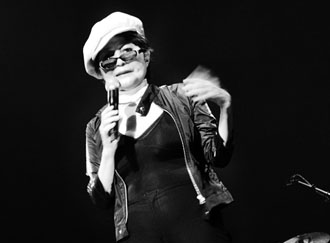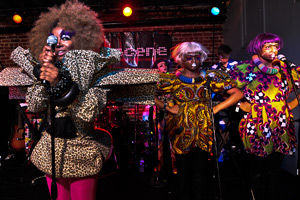
By <a href="http://www.flickr.com/photos/11027754@N03/3627022866">hidden shrine</a> under a CC license.
Yoko Ono still wants to reconnect humanity with its long-lost id. From Fluxus to songstress, the 77-year-old has used every free-associative vocal, literary, and visual avant-garde tool at her disposal to help resuscitate the uncensored thoughts of audiences around the world. Born in 1933 in Japan, Ono was the first female artist to market experimental primal wails as legitimate music at a time when demure vulnerability was prized over a woman’s angst-ridden screams. Her proto-feminist punk, often orgasmic vocals were inspired by childbirth; musically, her spawn includes bands like Deerhoof, Animal Collective, Sonic Youth, Bikini Kill and the whole riot grrrl gang—who owe their flagrant embrace of the loud and the absurd to Ono’s radical displays of freedom. I spoke with Ono—who performs at Noise Pop in San Francisco this week—about her work and to get her take on why female artists married to male artists often find their talent overshadowed. Prepare for sass.
Mother Jones: Musically, you were doing the uninhibited primal scream thing way before anyone else, I think…
Yoko Ono: That’s the truth, that’s the truth.
MJ: Which just makes it perfect that you’re headlining a show with Deerhoof. In the past, you’ve pointed to John Cage, Edgar Varese, Ornette Coleman and other free-jazz staples as musical inspirations.
YO: I wouldn’t say that they were my musical inspiration. Yes, there’s that too. But as a woman, I’d like to define it that it was both: They probably were inspired too.
MJ: Who inspired you vocally?
YO: Nobody. You know what happened. This is a story that I’ve told already, but when I was a very young girl, I was put in a summer house, and my mother was in Tokyo, and she said, “Make sure you don’t go to the servants’ room.” The servants room was way down in the other end of the summer house. But I was so like curious. So I sneak out and there were two young servants. There were many of them actually, but there were two young servants just talking to each other saying, “Did you know that my aunt just had a baby?” “Oh, really?” “And it was just very frightening because she was going like, “Oh, Oh, Oh, Aaaaahh!” And to give birth is a very painful thing. And all the servants were going, “Shut up!” But then I was thinking, “Oh gosh, it’s terrible.” But that sound I never forgot.
The male society is letting the men think of the women as something pretty and soft and that kind of thing, especially in those days, you know. So I just wanted to show what we were. Women are the ones who actually created the human race. I mean without us bringing up the new generation, there wouldn’t be a human race. So we have this very strong powerful energy in us. But the world wants to think that it’s the weaker sex. So that’s why I want to bring out this thing from me.
MJ: You performed that at Carnegie Recital Hall in 1961 using a tape played in reverse, the sound you’re just describing.
YO: It was just an accident that that happened.
MJ: That raises the point that your musical career came before you met John Lennon, but it’s often overshadowed by your relationship.
YO: Of course, of course. And many people often think, “Oh, so-and-so was doing that: Did you get an idea from them?” And when you really find out the dates, you know. I don’t think anybody was doing it when I was doing it in ‘61.
MJ: Why do women artists often find their work obscured by their partner’s talent?
YO: Well, we’re obscured because [men] want to obscure us because they’re totally frightened. I mean, we have so much power that if they start to admit that power they think that maybe they’re going to sort of lose something. They’re insecure. Of course, all of us are such insecure people, but because we have such power to actually create the human race, that’s really big, you know.
MJ: In your 1964 conceptual art book Grapefruit, you write that “The only sound that exists to me is the sound of the mind. My works are trying to induce music of the mind of people.” Why is it important for you for your work to be participatory?
YO: I just like that idea because, you know, we’re all like in this world together and we just have to have some energy flowing between us so that this whole planet will be healthier, you know. I want to wake up this beautiful super-power that each one of us has. You have to sort of, like, find it. And in order to find it, it’s good if we create a situation where we participate in artwork or music-work or something together.
MJ: Do you feel like the control you give audiences over your performance pieces can translate into the political world?
YO: Of course. I’m a politician. Politics is just a convenience for our life and we just have to create a beautiful world together that would be very convenient for us and just enjoyable. And we’re not getting there yet, but we will.
MJ: You were doing feminist performance art a decade before the Feminist Arts Program called upon women to build their art around their experiences as women. What got you doing it?
YO: It’s just in me. And I think I’m an observer in a way. And my life was not so—well, my life was bad too—but it’s just that I had the sense to cope with it. But it’s probably not that easy to cope if you’re in a society where you get killed when your husband dies. You’re pushed into the hole together or something. That’s the sort of terrible situation that women have to cope with. If I’m put into that position, probably I can’t deal with it either.
MJ: Feminist artist Carolee Schneeman once referred to you as “a very important Fluxus artist,” and that “we didn’t know if this rock and roll guy was going to be smart enough for her.” Listening to the first Plastic Ono Band album, it does seem pretty unrestrained relative to conventional rock ‘n’ roll. Would you have been able to deliver your avant-garde statements to a mainstream world were it not for your marriage to a Beatle?
YO: Well, I don’t know. I was doing it. Before I got together with John, you know, John Cage, Ornette Coleman, they appreciated my work and all that. It wasn’t like I was just buried underneath the ground or something.
MJ: But was it hard for you to unify your sensibilities with the mainstream?
YO: I didn’t think I had to be mainstream. I thought that I was creating my own universe—like when I was doing avant-garde things and I hit this thing, which was a film called Film Number 4, which was all about bottoms!
MJ: I’ve seen that one.
YO: Now that was so big that everyday newspapers in London were writing something about it maybe as a joke or something, but then I became famous for that. And then the newsreel was actually putting on one of my butt films to show a version of it, and say, “This is what they’re doing now. This is what this woman is doing. Ha Ha.” But the thing is, the avant-garde friends, some of them were very unhappy and they wouldn’t invite me to their dinner party because they were so embarrassed about it. I just don’t think that I became famous as an artist because I got together with John. And of course I did not become mainstream—ever. And just think about the number of records I sold.
MJ: You were on the Top 40 Billboard list for the best dance song of the decade.
YO: Yeah, dance song. Isn’t that great?
MJ: It’s amazing. It just goes to show that other people are picking up on your creativity.
YO: The thing is, it’s just vibrations. We’re dealing with vibrations called music. I just think that we should just cover this planet with music. It has a healing power and we need to heal, you know?
MJ: Would you say that music is your favorite of all the art forms you practice?
YO: No, I just said music. I would say the same thing with art, maybe. But music is quicker to spread than visual art, I think. Maybe not: These days there are ways of showing visual art and exposing visual art in a different way. I mean if it’s a billboard, then many people will see it maybe. But still music is something that even when you close your eyes it gets into your body.
MJ: You’ve collaborated with Cibo Matto’s Yuka Honda, Le Tigre, Cornelius, Sonic Youth. Basically artists whose music were influenced by your 1972 vocal experimentations. How are you influenced by your collaborators?
YO: I just think that we are sort of people on the same page. That’s all. And I don’t think of their age. We just got together and started doing this thing. It’s really good.
MJ: Are there other artists you’d like to collaborate with?
YO: I don’t think of the names. I might bump into them, just like I bump into Yuka and I bump into Cornelius. And I bumped into John Cage and Ornette Coleman too. It’s just bumping in, you know?
MJ: Can you explain how your instructional art methods tie into your message of peace?
YO: It has to do with participation. So you don’t just give a finished art work. You’re giving an instruction, and so then they have to participate; they have to do their own sort of production, and soon enough we understand that we’re all together—and there’s a connection with peace there. World peace is one project that we have to do together.
MJ: That participatory element is present in your current work as well. Last year, you judged the world’s first Twitter haiku competition in London. You also have thousands of Twitter followers who you respond to every Friday.
YO: They’re saying, “Is this really Yoko or something?” I’m sorry that I can’t send a reply to a thousand people, but the people that I reply to—they are definitely from me. You know, it’s like I’m writing them. It’s only like 20 of them a week; that’s a weekend.
MJ: In your interview with Takashi Murakami, you said that racism and sexism have improved among artists. Can you talk about the types of discrimination you’ve had to deal with?
YO: Well, you know, I can write a book about it but I’m not going to. Just imagine, imagine.
MJ: I was just hoping you coud talk about situations you’ve gotten into—how it’s changed since the ’70s for a Japanese artist.
YO: I think [people] are starting to have a little different kind of image about Japanese. Like when I was here for the first time, it was like people saying, “Oh, Madame Butterfly” and, you know, “Mount Fuji.” Those are two things they knew about Japan. Oh, and Geisha. Madame Butterfly, Geisha girls, and, you know, Mount Fuji and that’s it. And I thought, “Oh, dear. Is that the realization they have about Japanese women”? It was a laugh, really. And also, about sexism; you know, this is something that John and I did together—we just worked on it and so he was doing this exchange of roles with me—but the fact is that he was the first guy that really wrote a song about feminism. And when I go to the park now and see these men, they’re pushing strollers with babies in them. That never happened before John. He did it.
MJ: Why do you think you’re work is just now receiving critical acclaim?
YO: You tell me. I think their understanding about my work is getting a little bit better.
MJ: Last year, you came out with the album Between My Head and the Sky in which you collaborate with your son Sean and Cibo Matto’s Yuka Honda. You also set up more wish trees where people write their wishes and attach them to trees. And you have an autobiography coming out?
YO: No. Some Twitter fan sort of said, ‘When are you going to write your autobiography?” And I said, “Well I’m too busy to do that now, but maybe five years later,” and I shouldn’t have said five years because then most people do start to think she must have a contact already or something. No, I just meant any time in the future.
MJ: What’s next for Yoko Ono?
YO: Well, this is John’s 70th birthday year, so I’m going to be doing a lot of that and also Iceland where I have the Imagine Peace Tower—we light it every year on October 9. And then I go to Japan for a concert called Dream Power—that’s very important to me because we’ve been doing it for 10 years. And now we have a benefit for schools in Africa in in some Asian countries as well; we’ve created about 80 schools now. I think we’re expanding to South America too, and it’s just great, because education is very important, and in 10 years, to create 80 schools. I can’t believe it.
Click here for more Music Monday features from Mother Jones.














